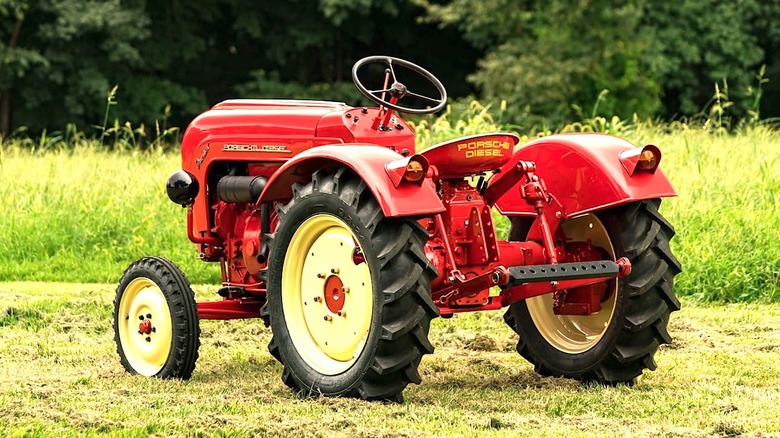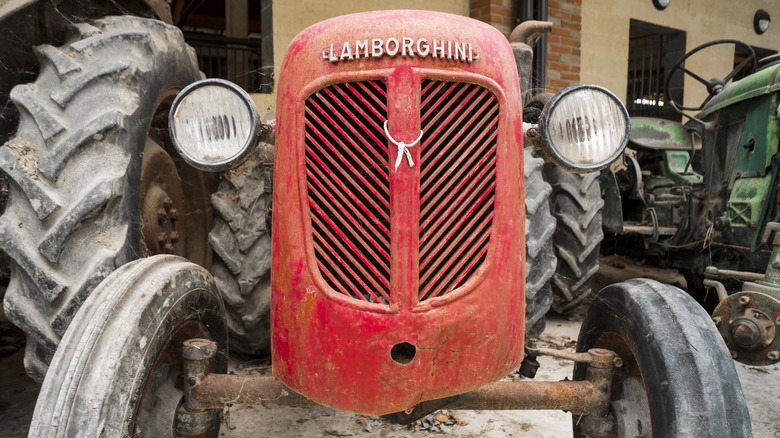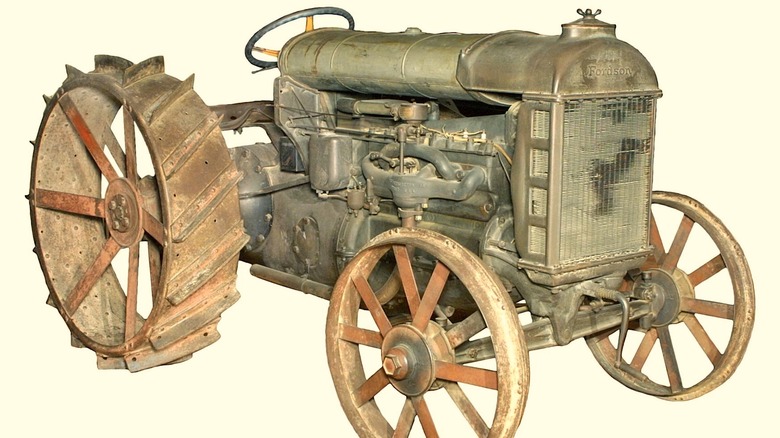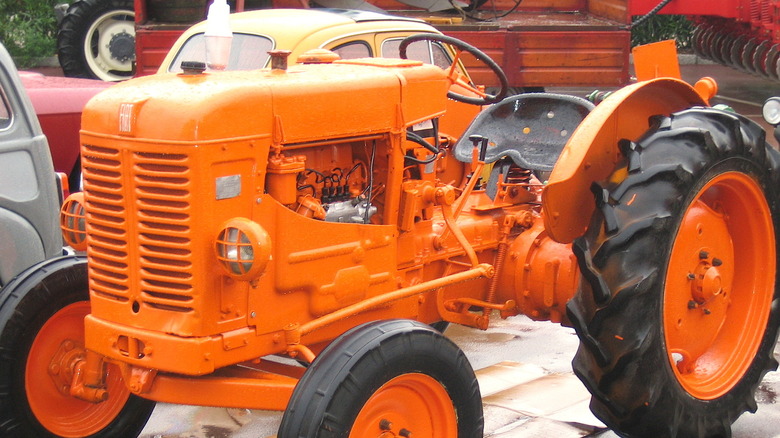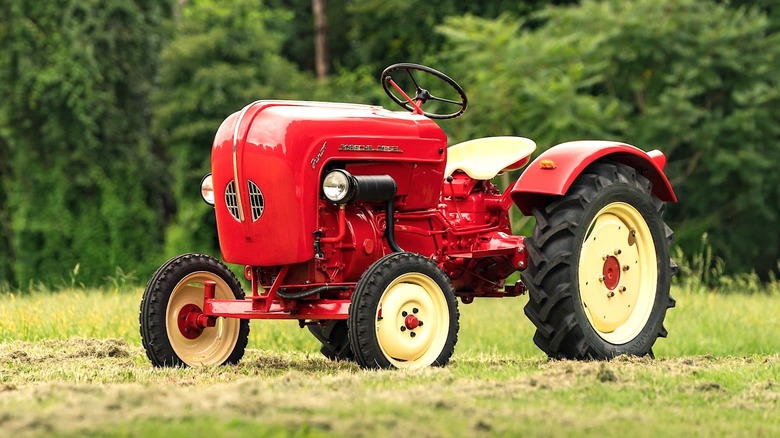4 Car Companies You Probably Didn't Realize Made Tractors
There are few if any, technological innovations that have revolutionized the agricultural world quite as much as the tractor. Born of the steam engine boom of the Industrial Revolution, the first steam-powered tractors were produced in the early 1900s, essentially eliminating a farmer's reliance on horses and oxen to pull heavy plows through a field and thus allowing them to cover infinitely more ground in a day's work.
Production, of course, increased exponentially with the development of the internal combustion engine, an advancement that required less manpower to keep a tractor plowing away through fertile fields. While the transition from steam to fossil fuels was slow, by the 1920s, it was far enough along in the United States that the country entered what many consider the golden age of tractors. From that era, one of the most prominent names in the agricultural machining game emerged, with John Deere delivering some of the most celebrated tractors in history, including the Model D and the uber-rare Orchid.
While John Deere has pioneered some of the best and the most expensive tractors in history, numerous other manufacturers have tried to replicate their success in the agricultural realm. And yes, several of those would-be tractor kings were automakers who'd already found success in the automobile arena. That trend would continue in North America and abroad for much of the 20th century. Here are some notable automobile manufacturers you may not realize also made tractors.
Lamborghini was making tractors before the legendary sports cars
It's safe to assume agricultural machines are not the first that comes to mind when you hear the name Ferruccio Lamborghini. After all, that name is far more synonymous with super-fast, low-profile sports cars that are equipped with those iconic scissor doors, not to mention an infamous feud with fellow Italian automaker Enzo Ferrari. But even as the Lamborghini name will no doubt forever be tied to the high-end sports car realm, it's worth noting that the legendary brand would likely not exist without its founder's ties to the agricultural industry.
After all, before he made his name in the auto game, Ferruccio Lamborghini spent his formative years toiling away on his parent's farm, learning all about the agricultural life and the machines that powered it. After serving in World War II, the soon-to-be automaker returned to Italy and founded Lamborghini Trattori, which was indeed dedicated to building powerful tractors that Italian farmers could actually afford rather than the expensive high-octane automobiles he'd come to be known for.
Lamborghini's first manufacturing venture proved a success, with the entrepreneur soon branching out into other markets, including, of course, sports cars. Despite the fact that the Lamborghini name is almost solely equated with those cars today, the Automobil Lamborghini came into being solely on the back of Ferruccio Lamborghini's success in the tractor biz. Though Ferruccio passed away in 1993, years after leaving the manufacturing biz in his rearview, tractors bearing the Lamborghini name are still working fields all across Europe today.
Ford produced its first tractors in the early days of the 20th Century
Ferruccio Lamborghini was hardly the first legendary auto manufacturer to make a line of tractors bearing his name, as Henry Ford also had great success in the early days of the tractor game. However, Ford took a different path into the agricultural arena, first producing celebrated automobiles before setting his sights on making tractors.
Ford had, of course, already revolutionized the American automobile industry with the 1908 release of the mass-production bound Model T. It was almost a decade later when Henry and his son Edsel produced their first agricultural tractor, with the aptly named Fordson hitting the scene in 1917. The release of the Fordson was hardly a fluke, as Ford and his design team had been attempting to develop an agricultural tractor for many years. As Lamborghini would also choose, Ford developed the Fordson as an affordable option that could help lighten the workload of everyday farmers across the country.
That approach would help ensure Ford's tractors were among the most sought-after on the market. By early 1920, 100,000 tractors with the Fordson label had already left the production line. Ford would soon drop the "son" from their tractors' nameplates and eventually don the red-on-gray and straight-blue liveries fans would come to know and love throughout the years. Though Ford has not been part of the tractor game since the early 1990s, their legacy lives on in the form of machines made by New Holland, a former business partner which was purchased by an Italian auto brand you probably didn't even know had skin in the tractor game.
Fiat tractors have been plowing fields in Italy since 1919
No, we're not talking about Lamborghini again, as it was ultimately Fiat that purchased the Ford New Holland shingle in 1991. Fiat would soon drop the Ford from the equation, with New Holland essentially becoming the company's standalone tractor and agricultural machinery brand. Though New Holland has kept Fiat in the tractor business for the past several decades, the automaker's history within the industry stretches back further than you likely realize.
Said history goes back more than 120 years, with Giovanni Agnelli and a team of investors first planting their flag in the Italian auto industry in 1900. Though Fiats would prove a hit with Italian drivers, almost two decades would pass before the country's farmers would discover the thrill of operating a vehicle from Fiat Trattori in the field. However, when the company's first tractors hit the scene in 1919, the 702 and 703 series builds would prove a popular choice for farmers across Europe.
Fiat would continue to produce tractors under the Trattori shingle for the next several decades, including the best-selling Fiat 18 (affectionately dubbed "La Piccola" because of its size), which hit the market in 1957. Fiat manufactured tractors and farm equipment under various names from the 1980s onward. While the Fiat brand proper is no longer making new tractors, not long after the company purchased Ford New Holland in 1991, it dropped the "Ford" moniker altogether, with the New Holland shingle now serving as Fiat's sole product line in the agricultural arena.
Porsche-Diesel tractors were only manufactured for a short time
If you're surprised to see the names of iconic automobile manufacturers like Lamborghini and Fiat listed among those who've also delved into agricultural machinery, you'll no doubt be just as shocked to see that of legendary German sports and racing car maker Porsche. But it's true, for a brief period of time stretching from the mid-1950s to early-1960s, Ferdinand Porsche indeed turned his company's focus to the world of tractors, doing so after working since 1931 to establish the Porsche brand as one synonymous with quality, speed, and precision.
But the Porsche founder harbored a long-held a desire to develop a tractor for the German agricultural market, having reportedly first had the idea after building an artillery tractor in 1914. Prior to World War II, he was reportedly even working with the country's government to produce an inexpensive "people's tractor," though the war forced Porsche to kill that passion project. Like many German companies, Porsche struggled to rebound in the postwar era, with Ferdinand's 1951 death further complicating matters. However, on the strength of its beloved 356 model, and licensing agreements for its diesel tractor engines, Porsche managed to recover and become the company we know today.
Of the tractors bearing the Porsche-Diesel name, it seems they were actually manufactured between 1956 and 1963 by a subsidiary company of then license holder, Mannessmann. Though the Porsche-Diesel Junior was popular in Europe, the tractors didn't sell well elsewhere, with Mannessmann pulling the plug on the line in '63. However, due to their relative scarcity, the sleekly designed, fire-engine red beauties are now highly sought-after on the vintage market.
